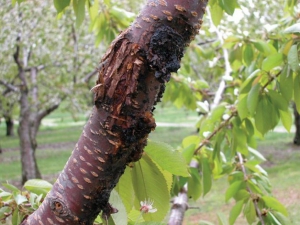
A classic bacterial canker symptom showing cankers and gummosis of woody tissue.
PHOTO COURTESY OF MICHIGAN STATE UNIVERSITY
12 STEPS TO MANAGE BACTERIAL CANKER
Tiffany Lillrose, a doctoral student at Michigan State University, found research conditions highly favorable for her work. “High spur mortality will affect yields for years to come,” she said, “and if infections become systemic, they may kill whole trees.”
Canker
In New York, Dr. Juliet Carroll has been working for some years on canker, along with Drs. Thomas Burr, Terence Robinson, Stephen Hoying, and Kerik Cox. She and Lillrose made presentations during the Great Lakes Expo in Grand Rapids, Michigan, in December, and Lillrose also spoke at the Northwest Michigan Orchard and Vineyard Show.
Current management practices focus on reducing populations of bacteria and maintaining optimal growing conditions for the trees, Carroll said. Because growth of the bacteria is favored by cool, moist conditions, applications of copper are applied in fall and spring. Best timing of these sprays has been found to be at 20 percent and 80 percent leaf drop in the fall and during the late dormant and prebloom period, not only because this is when weather is cool and moist, but, in fall, bacteria gain entry into buds and spurs via leaf scars.
“It is critical to maintain good soil fertility, plant trees on berms, provide irrigation, and to test for and eliminate nematodes prior to planting,” she advised. “Cankers and dead wood should be pruned when weather is dry.”
Predisposing factors associated with the disease include freeze injury, wounds through which the bacteria gain entrance, nematode damage, sandy and poorly drained soils, drought, and coinfection with canker fungi, such as perennial canker, she said.
She and her Cornell University associates carried out several experiments starting in 2006 to determine what management practices were effective against canker. They came to recommend that pruning be done using stub cuts—not flush cuts at the trunk— cutting out branches six inches or more away from the trunk. When canker infected the stubs, it was not able to run back to the trunk and damage the tree.
They tried treating the stubs with copper materials or phosphorous acid, but these failed to significantly reduce any infection following pruning.
“Pruning stubs lowered the risk of direct scaffold and trunk invasion by bacterial canker, based on observations of 315 trees, none of which developed trunk cankers from inoculated stubs,” she said. “Pruning stubs may serve to protect trees against bacterial canker by distancing the main trunk and scaffolds from bacterial invasion.”
She added that pruning stubs may be at greatest risk of canker infection during the late dormant pruning time. Pruning after harvest significantly reduced the risk of bacterial canker infection into pruning wounds. This may be related to either the physiological condition of the trees at that time or the typically hot, dry weather in late July and early August, which is unfavorable for development of the disease.
Work at MSU
Interest in bacterial canker in Michigan has been spurred by the desire to plant smaller cherry trees and support them on trellis wires, much as is done in training tall-spindle apples. But limb rub where wires contact the tree has resulted in bacterial canker infection.
As part of her previous work, Lillrose tested different kinds of wire. She found that steel wire resulted in 40 to 50 percent infection in inoculated trials. Using a plastic wire called Duraline reduced that to 10 percent, and there was no infection when a coated steel wire called PolyPlus was used.
In the humid climate of the eastern United States, bacterial canker is a constant threat, Lillrose said. It can enter trees through stomata on the leaves and leaf scars in fall, through pruning wounds, from points of winter injury, through cracks caused by herbicide damage, and through bark occlusions at narrow crotches.

does it affect the fruit is it does what can happen?